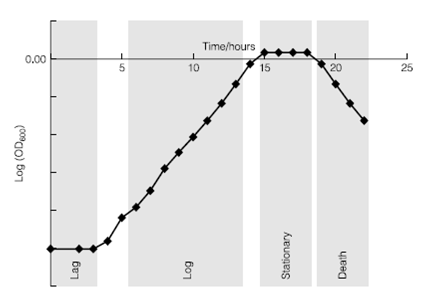Growth phases of a planktonic culture
With the data that can be derived from OD measurements it is now possible to draw a complete growth curve of a bacterium relating biomass to the changes in the state of the culture. If no new medium or medium components are added to the container this batch culture will give us information over the maximum amount of biomass that can be made using the medium components the specific growth rate and other information.
The growth curve of a bacterium growing in a shake-flask batch culture will have the form illustrated in Figure 3.The phases of growth can be divided into the lag, log or exponential stationary and death phases. The phases in among these main types are known as interphases and represent a switchover in the organism’s metabolism between one mode and another. If time = 0 is the point at which the culture was inoculated the shape of the growth curve can be explained:
? Lag phase During this period the organism adapts to the medium into which it has been introduced. If it was grown up in a medium containing a different carbon source of a less complex type or grown at a different temperature the lag phase can be long. The cells in the inoculum need to switch on new sets of genes and express new proteins to cope with the change in environment.

Figure . Growth of a bacterium in batch culture.
? Log phase Once all the necessary proteins are available the cells will start dividing as quickly as they can. It is only during this phase of exponential growth that the equations relating to specific growth are applicable.
? Stationary phase Log phase cells will continue to divide, but eventually one component of the medium will run out. Media are normally designed to be carbon limited example for the first thing to stop growth is the absence of a carbon source such as glucose or succinate but cultures may become limited through nitrogen, phosphorus, trace elements or essential amino acids. The cells are still metabolically active but do not have the resources to divide. This stationary phase seen in laboratory cultures is indicative of the state of organisms in oligotrophic environments.
? Death phase After some time metabolism stops and the cells starts to die and lyse.
The rate of lysis is constant over time. OD readings in this phase become unreliable as during lysis the cell debris now contributes to light scattering. Occasionally this is manifested in a slight increase in OD as the number of particles in solution increases.